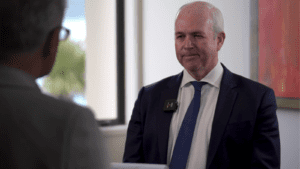More spending guidance during ‘Glory Years’ required: Wattle Partners
A vastly new approach to the notion of retirement that reshapes the way people draw down savings is required, according to retirement advice specialists Wattle Partners. Investors know how to make savings last, but they’re not always equipped with the confidence to spend it appropriately.
At a recent RASK event called ‘Making the most of your retirement‘, Wattle Partners founders Jamie Nemtsas (pictured, right) and Drew Meredith (centre) said the heavy focus on accumulation in Australia’s retirement system and financial services industry has taught people the importance of saving for their retirement, but neglected to place as much emphasis on the appropriate way to spend their retirement nest egg.
“Most of the financial services industry is set up for that accumulation, and most of the trillion dollars in industry funds are set up to basically keep contributing and keep earning,” Meredith said. “But there’s no set rule that says this amount of capital will be enough to generate this amount of income, because there are so many probabilities.”
With people living to much older ages, this is becoming an even more pressing challenge, as we now need our retirement savings to last at least 30 years, Nemtsas pointed out.
“So we have a finite level of capital and a timeframe we’re not too sure about,” he said. “That’s substantially different from managing the capital of a 30-year-old.”
Investors therefore need to alter everything, including how they balance their portfolios, what they do in markets and how they draw on their income.
As retirement approaches, one’s wealth accumulates, RASK founder Owen Raszkiewicz noted. “Suddenly, at 65, you’ve got a large sum of money you’ve worked really hard for, and there’s a lot of emotion that goes into that.”
That heightened level of emotion leads to common mistakes, with Meredith pointing to the tendency to make short-term decisions when people should be thinking over 25- or 30-year timeframe, for instance when it comes to downsizing. “We put a lot of emphasis on a single decision, and that flows into investing.”
And while the advice community attempts to gauge how much money will produce a certain amount of income by applying an inflation-based formula, that’s not how spending habits work, Nemtsas explained.
Investors instead need to consider three distinct periods of spending once they retire and budget accordingly, he said, noting that “the glory years is the first 10 years of retirement”, followed by a lower-spending period. The last 10 or 15 years are often marked by incapacitation or the loss of a partner, prompting spending to increase again, generally by selling off core assets.
The challenge for investors has become being able to maintain their lifestyle of choice post-retirement without fear of running out. Part of financial advisers’ jobs, Meredith said, is therefore to “give people confidence to spend at a similar level throughout retirement, assuming they have enough capital to fund that, rather than have this anchor in which we see a lot of clients expecting the same balance all the time.
“You need to understand that your capital will fall, which is the complete opposite experience from what you’ve had the rest of your life of saving.”











